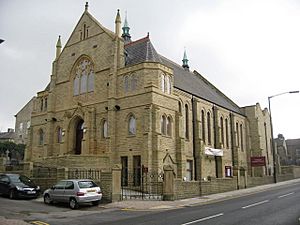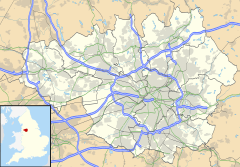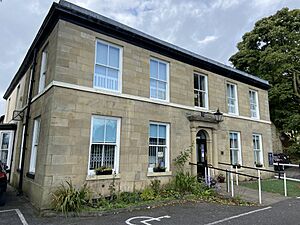Tottington, Greater Manchester facts for kids
Quick facts for kids Tottington |
|
|---|---|
 Tottington Methodist Church |
|
| Population | 9,783 (2011 Census) |
| OS grid reference | SD775130 |
| • London | 173 mi (278 km) |
| Metropolitan borough | |
| Metropolitan county | |
| Region | |
| Country | England |
| Sovereign state | United Kingdom |
| Post town | BURY |
| Postcode district | BL8 |
| Dialling code | 01204 |
| Police | Greater Manchester |
| Fire | Greater Manchester |
| Ambulance | North West |
| EU Parliament | North West England |
| UK Parliament |
|
Tottington is a town in Greater Manchester, England. It sits right on the edge of the West Pennine Moors. In 2011, about 9,783 people lived there.
Long ago, Tottington was part of Lancashire. It was a special type of royal land called a "fee" in the Middle Ages. This area included many smaller settlements, from Musbury and Cowpe in the north to Affetside and Walshaw. The main part of Tottington was a small farming village with open fields where wild animals like deer and boar lived.
Contents
History of Tottington
Tottington isn't mentioned in the famous Domesday Book, which listed everything in England after the Normans took over. We first hear about Tottington in 1212. Its name probably comes from an old English word meaning "Tota's farm" or "hilltop lookout point."
Tottington was once part of a much larger "Royal Manor of Tottington." This big area was owned by the King and included the northern part of Bury. Over time, parts of the manor were given away or sold. Eventually, Tottington became part of the Duchy of Lancaster. When the Duke of Lancaster became King Henry IV, the duchy became royal land, and so did Tottington.
Tottington Hall and Industry
Tottington Hall, a large house, was first mentioned in 1504. The Nuttall family lived there and became quite wealthy. In 1715, Thomas Nuttall built the first school in Tottington. Later, in 1770, John Gorton bought the hall. His family was rich from the cotton trade. John Gorton brought his business skills to Tottington. He built several mills, like Tottington Mill and Kirklees Mill. This helped the village grow a lot during the Georgian era. The Gorton family also paid for St Anne's Church and fixed up Tottington Hall. Today, Tottington Hall looks much like it did back then. In 1918, the local council bought the hall, and since 1974, it has been the village library.
Tottington grew a lot during the Industrial Revolution in the 1800s. Many factories, especially cotton mills, opened. By 1891, there were nine mills making cotton cloth and yarn. In 1884, a French scientist named Hilaire de Chardonnet worked in the area. He created an early type of rayon fabric, which was very pretty. However, it was also very easy to catch fire, so it was stopped. Later, the Kirklees Rayon Company made a safer type of rayon at the mill until 1955. The famous artist L. S. Lowry even drew Tottington Mill printworks in 1921.
Tottington Dungeon and Railways
As the population grew in the early 1800s, so did the number of pubs. To deal with people causing trouble, Tottington Dungeon was built in 1835. It was used to lock up drunks and other misbehaving people. No one knows who built it or who the carved faces on its stone walls represent.
In 1882, a railway line opened, connecting Bury to Holcombe Brook, passing through Tottington. This made it easier for people and goods to travel. The line was later taken over by a bigger railway company. Tottington railway station stayed open for passengers until 1952 and for goods until 1963. After the railway closed, the old track was turned into a 3-mile walking and cycling path called the Kirklees Trail in 1972.
World War II Bombing
On Christmas Eve in 1944, during the Second World War, Tottington was hit by a German V-1 flying bomb, also known as a "Doodlebug." It landed on Chapel Street, destroying houses and killing six people. Fourteen others were hurt. The bomb left a huge hole in the ground. St Anne's Church nearby had all its windows blown out. Later, the area was turned into a memorial garden to remember those who died.
Since the Second World War, Tottington has continued to grow. New homes have been built, often on the sites of old mills.
How Tottington is Governed
For a long time, Tottington Manor was split into two parts: Lower End and Higher End. Lower End included the village of Tottington and many smaller areas around it. Higher End covered much of what is now the Rossendale area.
In 1894, the old boundaries changed. Tottington Lower End became the Tottington Urban District Council. This council managed local services. In 1974, Tottington became part of the Bury Metropolitan Borough Council. This means Bury Council now looks after Tottington.
Tottington is part of the Bury North area for national elections. This area chooses one person to represent them in the UK Parliament in London. Since 2019, James Daly (Conservative) has been the Member of Parliament (MP) for Bury North.
Geography and Nature
Tottington is located where the West Pennine Moors meet the Rossendale Valley. To the north-west, Affetside Moor rises high, and further north, Holcombe Moor can be seen. From higher parts of Tottington, you can also see other moors to the east. Nearby villages include Affetside, Greenmount, Hawkshaw, and Walshaw.
For a long time, Tottington only grew along the main road from Bury to Blackburn. The Kirklees Valley to the east kept it separate from other towns. In the Kirklees Valley, there are old mill ponds and reservoirs. Many have dried up, but the ones that remain are great places for wild birds and bats to live.
The ground under Tottington is made of layers of clay, sandstones, and mudstones, with some coal. These are the same types of rocks found in the Lancashire Coalfield. While there's no history of coal mining in Tottington itself, many old buildings, like the dungeon, are made from local sandstone.
Community and Facilities
Tottington's main street, Market Street, has many local shops, including a vet, restaurants, a post office, and a Co-Op food store. There are also several pubs, like the Old Dungeon Inn, which is next to the Tottington Dungeon.
Both Tottington Primary School and Tottington High School are rated "good" by Ofsted, which inspects schools. There are four churches in the town: St Anne's (Church of England), St John's (Free Church of England), Tottington Methodist Church, and St Hilda's (Roman Catholic). The Tottington Medical Practice opened in 1995 and has eight doctor's surgeries.
The Tottington Cenotaph is a memorial dedicated to those who died in the First World War. It was built in 1930 from the same type of stone as the famous Cenotaph in London. It has a quote from William Shakespeare's play Julius Caesar.
The village library is in the historic Tottington Hall. In 2017, it was going to close, but a group of volunteers, led by Councillor Yvonne Wright, saved it. It reopened in 2018 as the Tottington Centre and Community Library.
Tottington is served by Tower FM local radio. The Sustrans National Cycle Route 6 runs through Tottington along the old railway line. There are also regular bus services to Bury.
The Tottington Public Band has been playing music since at least 1835, making it one of the oldest brass bands in the country! Tottington also has two amateur drama groups, a football club, and a cricket club. Since 2002, there has been an annual music festival and fair in the village. Even though it's a semi-rural area, Tottington has many parks and play areas, including Old Kay's Park and Town Meadow Park.
Landmarks in Tottington
- There are 24 historic buildings in Tottington that are "Grade II listed," meaning they are important and protected.
- St John with Trinity Free Church of England: Founded in 1853.
- Tottington Hall and gardens: Now used as the village library and a park.
- Whitehead Gardens: A memorial garden built where houses were hit by a V-1 bomb in 1944.
- Disused railway line to Holcombe Brook: This old line once had one of the world's first electric railways.
- Watling Street: An old Roman road that runs west of Tottington, connecting Manchester to Ribchester.
- Tottington Dungeon: A stone building with many carved faces and patterns, located at a road junction.
- Tottington Viaduct: A long bridge with nine arches that now carries the Kirklees Valley trail over Island Lodge Pond. It was built for the railway in 1882.
Famous People from Tottington
Many interesting people have connections to Tottington:
- Sir Edward Holden, 1st Baronet (1848–1919): A famous banker who helped develop Midland Bank.
- Antony Cotton (born 1975): An actor known for his role in the popular TV show Coronation Street. He grew up in Tottington.
- Tony Irving (born 1976): A former dancing champion and TV star in Scandinavia. His family still lives in Tottington.
- Lisa Riley (born 1976): A TV presenter and actress from Emmerdale. She was born and grew up in Tottington.
- Vicky Binns (born 1982): An actress who has been in Emmerdale and Coronation Street.
- Craig Potter, Pete Turner, and Richard Jupp: Members of the band Elbow. They grew up in Tottington and even had their first band practices at St Anne's Church Hall.
- Lady Tottington: A character in the animated movie Wallace & Gromit: The Curse of the Were-Rabbit. She is named after Tottington Hall!
Sport
- Len Crompton (1902–after 1930): A professional football goalkeeper born in Tottington.
- Bill Doran (1916–1973): A World Championship Motorcycle Racer from the 1950s, also born in Tottington.
Images for kids




